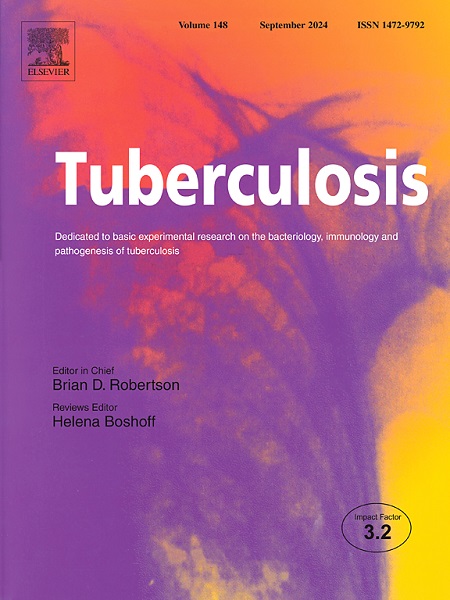Identification of monocyte-associated genes MSRB2, CLEC4D, and ASGR2 as potential biomarkers for tuberculosis via machine learning and mendelian randomization
IF 2.9
3区 医学
Q3 IMMUNOLOGY
引用次数: 0
Abstract
Objective
This study explores the link between immune cells and tuberculosis (TB) pathogenesis and progression, proposing diagnostic strategies based on immune microenvironment changes.
Methods
The CIBERSORT algorithm assessed immune cell infiltration in TB tissues, validated by routine blood tests. Differential expression analysis and WGCNA identified key genes and modules. GO and KEGG analyses elucidated biological functions. Machine learning pinpointed diagnostic biomarkers and built a predictive model. Further validation included GSVA, single-cell data, Mendelian randomization, and RT-qPCR.
Results
Analysis of the immune microenvironment in TB patients and healthy controls revealed monocytes as the predominant immune cell type. A total of 90 overlapping genes were identified through differential expression analysis and WGCNA. A diagnostic model incorporating MSRB2, CLEC4D, and ASGR2 was constructed using three distinct machine learning algorithms and logistic regression. Single-cell data analysis demonstrated that these three genes were predominantly expressed in mononuclear cells of TB patients. MR analysis further established a causal relationship between CLEC4D and an elevated risk of TB.
Conclusion
We established a monocyte-based diagnostic model demonstrating robust predictive accuracy. MSRB2, CLEC4D, and ASGR2 represent promising therapeutic targets for TB immunotherapy, providing potential breakthroughs in diagnostic precision and treatment efficacy.
通过机器学习和孟德尔随机化鉴定单核细胞相关基因MSRB2、cle4d和ASGR2作为结核病的潜在生物标志物
目的探讨免疫细胞与结核病发病进展的关系,提出基于免疫微环境变化的诊断策略。方法CIBERSORT算法评估TB组织免疫细胞浸润,并通过血常规检查验证。差异表达分析和WGCNA鉴定关键基因和模块。GO和KEGG分析阐明了其生物学功能。机器学习确定了诊断性生物标志物,并建立了预测模型。进一步的验证包括GSVA、单细胞数据、孟德尔随机化和RT-qPCR。结果结核患者和健康对照者的免疫微环境分析显示,单核细胞是主要的免疫细胞类型。通过差异表达分析和WGCNA共鉴定出90个重叠基因。采用三种不同的机器学习算法和逻辑回归构建了包含MSRB2、cle4d和ASGR2的诊断模型。单细胞数据分析表明,这三个基因主要在结核病患者的单核细胞中表达。MR分析进一步确立了cle4d与结核病风险升高之间的因果关系。结论我们建立了一种基于单核细胞的诊断模型,具有较强的预测准确性。MSRB2、CLEC4D和ASGR2是结核病免疫治疗有前景的治疗靶点,在诊断精度和治疗疗效方面有潜在突破。
本文章由计算机程序翻译,如有差异,请以英文原文为准。
求助全文
约1分钟内获得全文
求助全文
来源期刊

Tuberculosis
医学-呼吸系统
CiteScore
4.60
自引率
3.10%
发文量
87
审稿时长
49 days
期刊介绍:
Tuberculosis is a speciality journal focusing on basic experimental research on tuberculosis, notably on bacteriological, immunological and pathogenesis aspects of the disease. The journal publishes original research and reviews on the host response and immunology of tuberculosis and the molecular biology, genetics and physiology of the organism, however discourages submissions with a meta-analytical focus (for example, articles based on searches of published articles in public electronic databases, especially where there is lack of evidence of the personal involvement of authors in the generation of such material). We do not publish Clinical Case-Studies.
Areas on which submissions are welcomed include:
-Clinical TrialsDiagnostics-
Antimicrobial resistance-
Immunology-
Leprosy-
Microbiology, including microbial physiology-
Molecular epidemiology-
Non-tuberculous Mycobacteria-
Pathogenesis-
Pathology-
Vaccine development.
This Journal does not accept case-reports.
The resurgence of interest in tuberculosis has accelerated the pace of relevant research and Tuberculosis has grown with it, as the only journal dedicated to experimental biomedical research in tuberculosis.
 求助内容:
求助内容: 应助结果提醒方式:
应助结果提醒方式:


